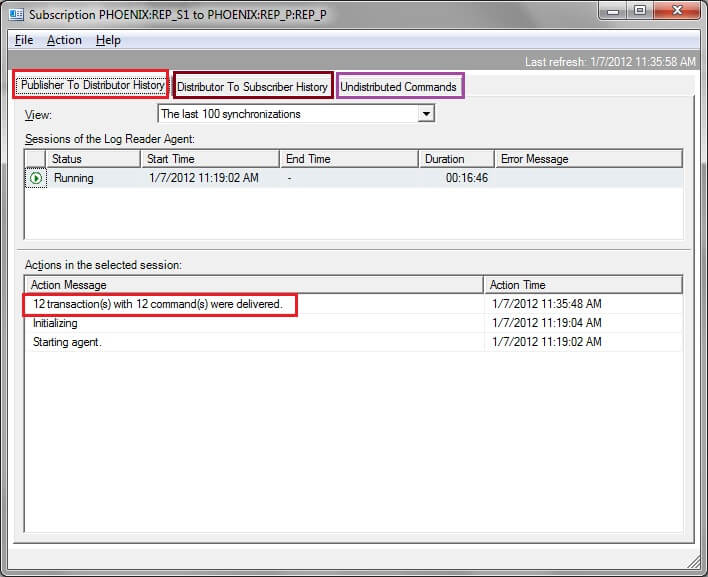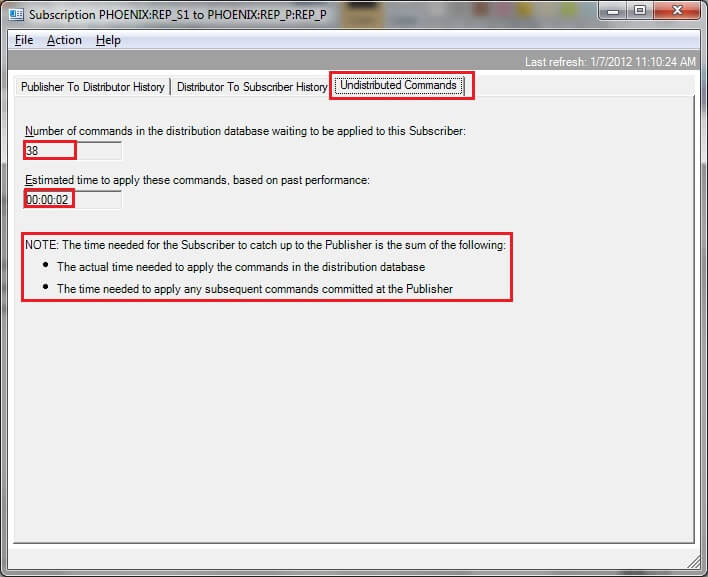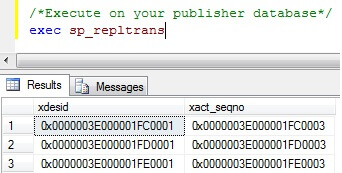Determine data latency between Publisher and Subscriber in SQL Server Transactional Replication
Ref:
http://www.mssqltips.com/sqlservertip/2590/determine-data-latency-between-publisher-and-subscriber-in-sql-server-transactional-replication/
To find out what still needs to be replicated, we could use both Replication Monitor as well as T-SQL commands to find out how what needs to be replicated to the subscriber database. Both options assume transactional replication is already configured in your environment.
Option 1: Using Replication Monitor
In SQL Server Management Studio (SSMS), navigate to Replication and right click and select 'Launch Replication Monitor'. Go to your listed server and expand it. Click on your publication and on the right side pane under the 'All Subscriptions' tab, go to your subscription and double click on it. Once done, you would see this window.

Option 2: Using Replication commands
Run this on publisher databaseTo check if replication is fine, we could run sp_repltrans on the publisher database. This displays the undistributed commands present in the publisher database. If your log reader agent is scheduled to run continuously and if this command returns no rows, replication is fine on the publisher side. However, if your log reader agent is scheduled to run at intervals and there are changes that need to be sent to the distribution database, you would see rows returned when you execute (during the interval) this procedure which shows the LSNs of the transactions. See sample screenshot below.

Run this on distribution database
The distribution database contains the system tables - MSrepl_commands and MSrepl_transactions which contain details of the replicated commands. Here is a sample output of a select query on these system tables.
select * from distribution.dbo.MSrepl_commands select * from distribution.dbo.MSrepl_transactions

In the above example, if we need to find out the actual command corresponding to xact_seqno = '0x00000085000002A10003' and command_id = 1, we could execute sp_browsereplcmds with these parameters. See screenshot and sample script below.
Use distribution
exec sp_browsereplcmds @xact_seqno_start = '0x00000085000002A10003',
@xact_seqno_end = '0x00000085000002A10003',
@publisher_database_id = '1', -- run sp_helppublication on publisher database
@command_id = '1' -- command_id in MSrepl_commands table distribution database

In option 1, using replication monitor, we saw how to view the 'undistributed commands'. The same data could be obtained by executing sp_replmonitorsubscriptionpendingcmds in the distribution database. Use sample script below.
sp_replmonitorsubscriptionpendingcmds @publisher ='Enter publisher server name', @publisher_db = 'Enter publisher database name', @publication ='Enter name of publication', @subscriber ='Enter subscriber server name', @subscriber_db ='Enter subscriber database name', @subscription_type ='0' --0 for push and 1 for pull

Testing
In your test replication environment, you could stop the distribution agent job and run a few insert commands in the publisher database. Once done, execute this procedure sp_replmonitorsubscriptionpendingcmds in the distribution database to find out the details of the pending commands to be applied on to the subscriber. Then proceed to query the MSrepl_commands and MSrepl_transactions system tables in the distribution database to determine the actual commands that are yet to be sent to the subscriber. Using MSrepl_transactions system table you could get the time you had executed the insert statements in your publisher database. Then make use of the sp_browsereplcmds as shown above to find out the full text of commands by providing the appropriate parameters. This would give an idea of the actual commands that are yet to be replicated to the subscriber.You can also use this script to query the distribution system tables.
select rc.publisher_database_id, rc.xact_seqno, rc.command, rt.entry_time from MSrepl_commands rc, MSrepl_transactions rt where rc.xact_seqno = rt.xact_seqno
It should be noted that the data available in MSrepl_commands, MSrepl_transactions, sp_browsereplcmds is purged periodically based on the schedule of the distribution clean up job and the distribution retention period.

No comments:
Post a Comment